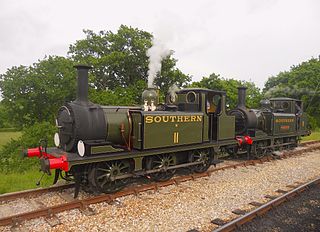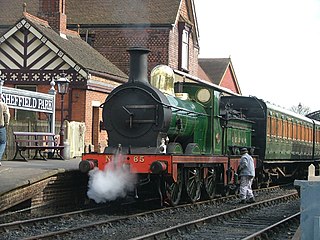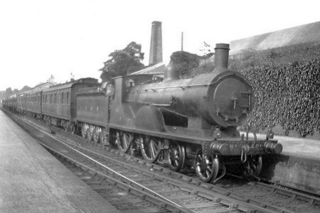
The National Railway Museum (NRM) is a museum in York, England, forming part of the Science Museum Group. The museum tells the story of rail transport in Britain and its impact on society. It is the home of the national collection of historically significant railway vehicles such as Mallard, Stirling Single, Duchess of Hamilton and a Japanese bullet train. In addition, the National Railway Museum holds a diverse collection of other objects, from a household recipe book used in George Stephenson's house to film showing a "never-stop railway" developed for the British Empire Exhibition. It has won many awards, including the European Museum of the Year Award in 2001.

The Great Central Railway (GCR) is a heritage railway in Leicestershire, England, named after the company that originally built this stretch of railway. It runs for 8.25 miles (13.28 km) between the town of Loughborough and a new terminus in the north of Leicester. It has period signalling, locomotives and rolling stock.

Le Morte d'Arthur is a 15th-century Middle English prose reworking by Sir Thomas Malory of tales about the legendary King Arthur, Guinevere, Lancelot, Merlin and the Knights of the Round Table, along with their respective folklore. In order to tell a "complete" story of Arthur from his conception to his death, Malory compiled, rearranged, interpreted and modified material from various French and English sources. Today, this is one of the best-known works of Arthurian literature. Many authors since the 19th-century revival of the legend have used Malory as their principal source.
The SR N15X class or Remembrance class were a design of British 4-6-0 steam locomotives converted in 1934 by Richard Maunsell of the Southern Railway from the large LB&SCR L class 4-6-4 tank locomotives that had become redundant on the London–Brighton line following electrification. It was hoped that further service could be obtained from these locomotives on the Southern's Western Section, sharing the duties of the N15 class locomotives. The locomotives were named after famous Victorian engineers except for Remembrance, which was the LBSCR's memorial locomotive for staff members who died in the First World War.

The LSWR N15 class was a British 2–cylinder 4-6-0 express passenger steam locomotive designed by Robert Urie. The class has a complex build history spanning three sub-classes and ten years of construction from 1918 to 1927. The first batch of the class was constructed for the London and South Western Railway (LSWR), where they hauled heavy express passenger trains to the south coast ports and further west to Exeter. After the Lord Nelsons, they were the second biggest 4-6-0 passenger locomotives on the Southern Railway. They could reach speeds of up to 90 mph (145 km/h).

The London, Midland and Scottish Railway (LMS) Ivatt Class 2 2-6-2T is a class of light 'mixed-traffic' steam locomotive introduced in 1946.

The SR V class, more commonly known as the Schools class, is a class of steam locomotive designed by Richard Maunsell for the Southern Railway. The class was a cut down version of his Lord Nelson class but also incorporated components from Urie and Maunsell's LSWR/SR King Arthur class. It was the last locomotive in Britain to be designed with a 4-4-0 wheel arrangement, and was the most powerful class of 4-4-0 ever produced in Europe. All 40 of the class were named after English public schools, and were designed to provide a powerful class of intermediate express passenger locomotive on semi-fast services for lines which could cope with high axle loads but some of which had short turntables.

The London, Brighton and South Coast Railway (LB&SCR) A1 class is a class of British 0-6-0T steam locomotive. Designed by William Stroudley, 50 members of the class were built in 1872 and between 1874 and 1880, all at Brighton railway works. The class has received several nicknames, initially being known as "Rooters" by their south London crews. However, the engines were more famously known as "Terriers" on account of the distinctive 'bark' of the exhaust beat. Later in their careers, some engines were known as "Hayling Billy" on account of their work on the Hayling Island branch line. A pub of this name on the island was briefly home to the engine which is now No. W8 Freshwater.

The SR class LN or Lord Nelson class is a type of 4-cylinder 4-6-0 steam locomotive designed for the Southern Railway by Richard Maunsell in 1926. They were intended for Continental boat trains between London (Victoria) and Dover harbour, but were also later used for express passenger work to the South-West of England. Sixteen of them were constructed, representing the most powerful Southern 4-6-0 design. They were all named after famous admirals.

The South Eastern and Chatham Railway (SECR) P class is a class of 0-6-0T steam locomotive designed by Harry Wainwright.

The LSWR S15 class is a British 2-cylinder 4-6-0 freight steam locomotive designed by Robert W. Urie, based on his H15 class and N15 class locomotives. The class had a complex build history, spanning several years of construction from 1920 to 1936. The first examples were constructed for the London and South Western Railway (LSWR), where they hauled freight trains to the south coast ports and further west to Exeter, as well as occasional passenger work in conjunction with their larger-wheeled N15 class counterparts.

London, Midland and Scottish Railway (LMS) Stanier Class 5 4-6-0 No. 5305 is a preserved British steam locomotive. In preservation, it has carried the name Alderman A.E. Draper, though it never carried this in service. It was named after Albert Draper, the man who rescued the locomotive in his own scrapyard.

The SR USA class are some ex-United States Army Transportation Corps S100 Class steam locomotives purchased and adapted by the Southern Railway (SR) after the end of the Second World War to replace the LSWR B4 class then working in Southampton Docks. SR staff nicknamed them "Yank Tanks".

The South Eastern Railway (SER) O Class was a class of 0-6-0 steam locomotive designed for goods work, and were the main goods engines of the SER, and later the South Eastern and Chatham Railway (SECR) for a number of years. However, they were displaced by the more powerful C class locomotives following the amalgamation of the South Eastern Railway and London, Chatham and Dover Railway (LCDR) in 1899. This relegated the class to working on the numerous branch lines in Kent, on both passenger and goods work. They worked most notably on the Kent & East Sussex Railway and East Kent Railway, operating coal trains from the Kent coal fields to London, as well as shunting work at such locations as Shepherds Well, Hoo Junction and Ashford. The majority were withdrawn before the outbreak of the Second World War in 1939, and those that remained were slowly withdrawn from nationalisation onwards.
King Arthur is a legendary king of the Britons.

The London and South Western Railway T9 class is a class of 66 4-4-0 steam locomotive designed for express passenger work by Dugald Drummond and introduced to services on the LSWR in 1899. One example has been preserved after British Railways ownership. They were given the nickname of "Greyhounds" due to their speed, up to 85 miles per hour (137 km/h), and reliability.

The Fifteen Guinea Special was the last main-line passenger train to be hauled by steam locomotive power on British Rail on 11 August 1968 before the introduction of a steam ban that started the following day, the extra day added to allow for the movement of locomotive BR Standard Class 7 70013 Oliver Cromwell to Bressingham Steam Museum. It was a special rail tour excursion train organised for the occasion from Liverpool Lime Street via Manchester Victoria to Carlisle and back, and was pulled in turn by four steam locomotives during the four legs of the journey. The last scheduled standard gauge steam-hauled passenger services had run on 3 August 1968 from Preston. Steam continued to be used on the narrow gauge Vale of Rheidol Railway under British Rail, which was subsequently privatised in 1989.
The Bluebell Railway is a heritage line West Sussex and East Sussex in England.

W24 Calbourne is an example of the Adams LSWR O2 class 0-4-4T, which is based at the Isle of Wight Steam Railway. It is the sole survivor of its class.

Locomotive Services Limited is a train operating company in Great Britain. The company operates rail tours using heritage steam, diesel and electric locomotives with support from associated companies and trusts.

















